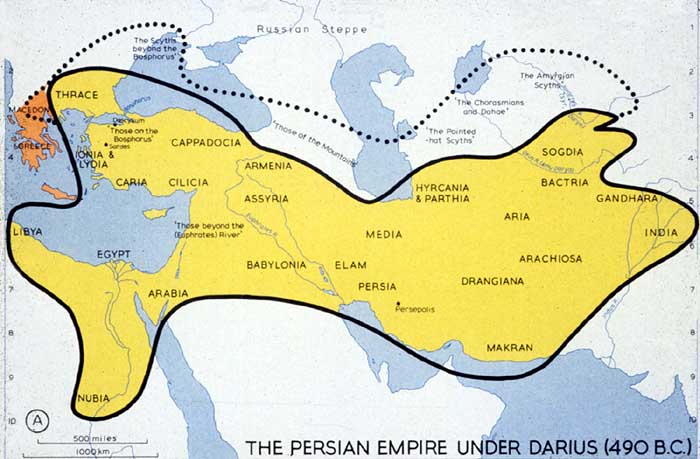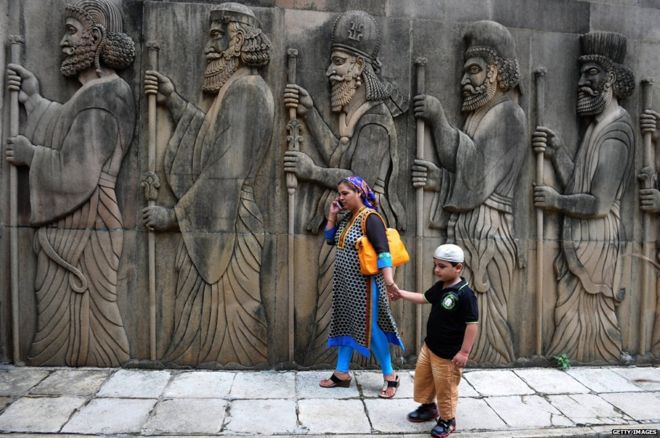Zoroastrianism - The Amazing Pre-islamic Religion Of Persians And Central Asians - Religion - Nairaland
Nairaland Forum / Nairaland / General / Religion / Zoroastrianism - The Amazing Pre-islamic Religion Of Persians And Central Asians (2347 Views)
Connection Between Zoroastrianism And Islam / The Law Of God And The Law Of Medes And Persians. / The Amazing city of pure Gold, Diamonds and precious stones. (2) (3) (4)
(1) (Reply)
| Zoroastrianism - The Amazing Pre-islamic Religion Of Persians And Central Asians by BlauGully: 1:53am On Oct 21, 2017 |
 Zoroastrianism (Also known as Behdin meaning "The best religion"  is an ancient religion, believed to have been preached by the ancient Persian prophet Zoroaster/Zarathustra over 3000 years ago, Over 1000 years before Jesus was born and nearly over 2000 years before Islam. It was a religion practiced throughout Central Asia and Persia (Persia being the Iranian speaking lands of the time - most of central Asia was filled with Iranian speakers and not Turks then). It is believed to have had influence on Judaism and Early Christianity, particularly because of it's beliefs of monotheism and it's beliefs regarding concepts of good and evil and morality. is an ancient religion, believed to have been preached by the ancient Persian prophet Zoroaster/Zarathustra over 3000 years ago, Over 1000 years before Jesus was born and nearly over 2000 years before Islam. It was a religion practiced throughout Central Asia and Persia (Persia being the Iranian speaking lands of the time - most of central Asia was filled with Iranian speakers and not Turks then). It is believed to have had influence on Judaism and Early Christianity, particularly because of it's beliefs of monotheism and it's beliefs regarding concepts of good and evil and morality.However, Zoroastrianism was not an Abrahamic or Semitic religion in origin like Christianity, Islam and Judaism. In fact, it was an Iranian/Aryan religion, originating from the religion of Iranian tribes. Examples: Humata, Hukhta, Huvarshta, which mean: Good Thoughts, Good Words, Good Deeds. There is only one path and that is the path of Truth. Do the right thing because it is the right thing to do, and then all beneficial rewards will come to you also. Zoroastrianism was the religion of the first Persian Empire's famous founder, Cyrus the Great. Cyrus, unlike many other rulers of the Near East such as the Assyrians or Babylonians, did not pursue policies of "assimilate or die" towards peoples who were not his own, instead giving them greater autonomy where they were majorities and awarding them major positions in government. Cyrus is famously referred to in the Bible as "God's Chosen One", due to the fact that he sent policies and the military in to stop the violent persecution of Jews in the Fertile Crescent and saved the lives of the ancient Hebrew community.  The Avesta is the religion's Bible, written in the ancient East Iranian language Avestan, a language closely related to Sogdian, Scythian, Bactrian and to modern day Pashto and the Pamiri languages between Afghanistan, Pakistan and China. Another language connected to the religion was of course Old Persian, an ancient West Iranian language related to modern day Persian (Farsi,Dari) and Kurdish. From Wikipedia: Zoroastrians believe that there is one universal, transcendent, supreme god, Ahura Mazda, or the "Wise Lord". (Ahura means "Being" and Mazda means "Mind" in Avestan language).[24] Zoroaster keeps the two attributes separate as two different concepts in most of the Gathas and also consciously uses a masculine word for one concept and a feminine for the other, as if to distract from an anthropomorphism of his divinity. Zoroaster claimed that Ahura Mazda is almighty, though not omnipotent. Other scholars assert that since Zoroastrianism's divinity covers both being and mind as immanent entities, it is better described as a belief in an immanent self-creating universe with consciousness as its special attribute, thereby putting Zoroastranism in the pantheistic fold where it can be easily traced to its shared origin with Indian Brahmanism.[25][26] In any case, Ahura Mazda's creation—evident is widely agreed as asha, truth and order—is the antithesis of chaos, which is evident as druj, falsehood and disorder. The resulting conflict involves the entire universe, including humanity, which has an active role to play in the conflict.[27] In Zoroastrian tradition, the "chaotic" is represented by Angra Mainyu (also referred to as "Ahriman"  , the "Destructive Principle", while the benevolent is represented through Ahura Mazda's Spenta Mainyu, the instrument or "Bounteous Principle" of the act of creation. It is through Spenta Mainyu that transcendental Ahura Mazda is immanent in humankind, and through which the Creator interacts with the world. According to Zoroastrian cosmology, in articulating the Ahuna Vairya formula, Ahura Mazda made His ultimate triumph evident to Angra Mainyu. As expressions and aspects of Creation, Ahura Mazda emanated the Amesha Spentas ("Bounteous Immortals" , the "Destructive Principle", while the benevolent is represented through Ahura Mazda's Spenta Mainyu, the instrument or "Bounteous Principle" of the act of creation. It is through Spenta Mainyu that transcendental Ahura Mazda is immanent in humankind, and through which the Creator interacts with the world. According to Zoroastrian cosmology, in articulating the Ahuna Vairya formula, Ahura Mazda made His ultimate triumph evident to Angra Mainyu. As expressions and aspects of Creation, Ahura Mazda emanated the Amesha Spentas ("Bounteous Immortals" , that are each the hypostasis and representative of one aspect of that Creation. These Amesha Spenta are in turn assisted by a league of lesser principles, the Yazatas, each "Worthy of Worship" and each again a hypostasis of a moral or physical aspect of creation. , that are each the hypostasis and representative of one aspect of that Creation. These Amesha Spenta are in turn assisted by a league of lesser principles, the Yazatas, each "Worthy of Worship" and each again a hypostasis of a moral or physical aspect of creation.Zoroastrian theology includes a duty to protect nature. This has led some to proclaim it as the "world's first ecological religion." Scholars have argued that, since the protections are part of a ritual, they stem from theology rather than ecology. Others have responded that, since the scripture calls for the protection of water, earth, fire, air, as one of its strongest precepts, it is, in effect, an ecological religion: "It is not surprising that Mazdaism (another term for Zoroastrianism) is called the first ecological religion. The reverence for Yazatas (divine spirits) emphasizes the preservation of nature (Avesta: Yasnas 1.19, 3.4, 16.9; Yashts 6.3–4, 10.13)." [28]  Painting depicting Zoroastrians at a Fire Temple in Baku, Azerbaijan. Zoroastrians hold fire and water as symbols of life and sacred. Zoroastrian Temples were also known as fire temples, due to the fact that there were fires within them that were always burning. Many Temples used solid proto-petroleum stones, which can burn constantly over thousands of years, within the temples of the everlasting flame. It is possible that some of the burning proto-petroleum stones in Azerbaijan, Yazd and elsewhere have not once gone out in over 1000 years.  A mural from Panjakent, 6th century of Sogdians. Sogdians were an East Iranian people who once commanded a mighty empire of the silk road. As with other regions of Persia and Central Asia, the Sogdians were mainly Zoroastrians. Modern day Tajiks and other tribes/peoples around Afghanistan and Tajikistan are believed to be partly descended from Sogdians.  A mummy of a Scythian Warrior from over 2000 years ago. He has tattoos aligning to spirits and demons similar to those within the Zoroastrian faith - possibly indicating that they either followed the faith or a primordial Iranian faith connected to it. The Scythians were an ancient Iranian people who lived nomadic lives on horseback in the steppes of Northern Eurasia, and were also known for having women warriors as well as men, and for creating the first trousers (fun fact: ancient Greeks refused to wear pants over their skirts or robes because they thought they were not "manly". How times change!).   More Scythian tattoos. The top tattoos of a big cat, likely a lion or tiger, mauling or killing a Stag or Bull, is common imagery in both Zoroastrian and more widely Iranian symbology.  Zoroastrianism heavily declined after the Arab-Muslim invasion of Persia and the creation of the first Caliphates, under Arab rule Zoroastrianism was gradually decimated and replaced by Islam, partly through jizya tax of non-Muslims and encouragement to convert to Islam, and of violent repression and murder of any Zoroastrians who tried to rise up against or challenge Muslim rule. Mohammad personally disliked the fact that Zoroastrian Persia was ruled by a woman, and many Muslims grew neckbeards without moustaches to contrast to the moustaches of the Zoroastrians. Nevertheless, Zoroastrianism has survived as a religion to this very day, albeit in very small numbers. One of the most significant of Zoroastrian communities are the Parsis of India, descendants of Persian Zoroastrians who fled to India during the early Muslim age.  A Parsi mother and child(?) walk past a Zoroastrian Mural in India.  Parsi Zoroastrian Priests practicing Jashan, a Zoroastrian mass, India. |
| Re: Zoroastrianism - The Amazing Pre-islamic Religion Of Persians And Central Asians by folashade96(f): 1:59am On Oct 21, 2017 |
Op you are a very smart person |
| Re: Zoroastrianism - The Amazing Pre-islamic Religion Of Persians And Central Asians by BlauGully: 4:47am On Oct 21, 2017 |
folashade96: No my friend just curious Zoroastrianism is also interesting in that it deviates a LOT from other traditional Indo-European religions. Other Indo-European religions had a lot of similarities e.g. Norse mythology's Tyr = Greek Mythology's Zeus = Hinduism's/Vedic religion's Dyaus-Pitah, with similar pantheons of gods and goddesses, but Zoroastrianism is very different. It was very revolutionary when it first appeared. |
(1) (Reply)
Reinhard Bonnke Final Words And Message Before Death. / What My Phone Did When I Told It To Prove To Me That Its Maker Exists - jesusjnr / If Jesus Calls The Father " The Only True God" Does That Mean Jesus Is Not God?
(Go Up)
| Sections: politics (1) business autos (1) jobs (1) career education (1) romance computers phones travel sports fashion health religion celebs tv-movies music-radio literature webmasters programming techmarket Links: (1) (2) (3) (4) (5) (6) (7) (8) (9) (10) Nairaland - Copyright © 2005 - 2024 Oluwaseun Osewa. All rights reserved. See How To Advertise. 24 |